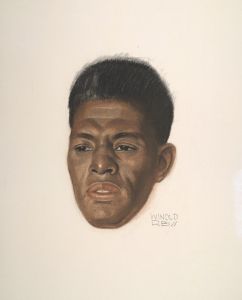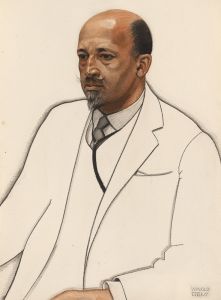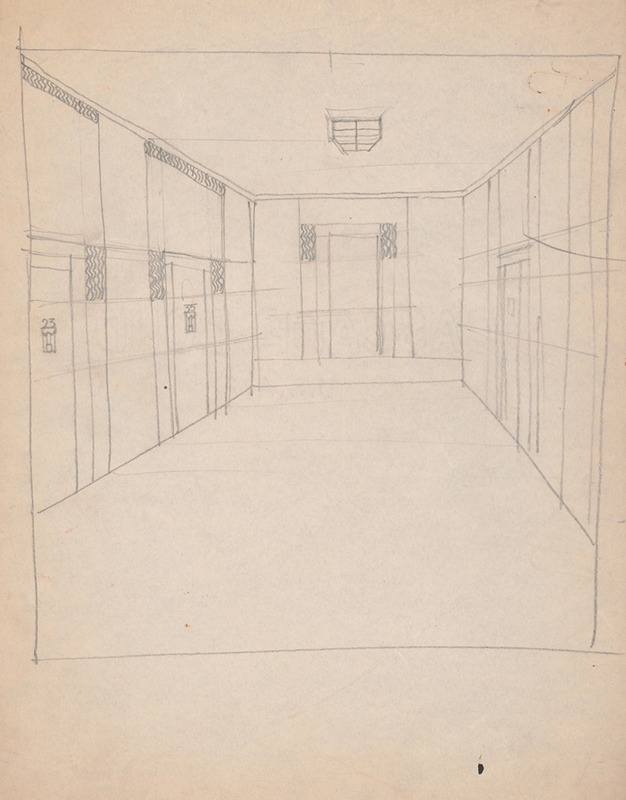
Design sketches for Hotel Alamac, 71st and Broadway, New York, NY. Plan of hallway
A hand-painted replica of Winold Reiss’s masterpiece Design sketches for Hotel Alamac, 71st and Broadway, New York, NY. Plan of hallway, meticulously crafted by professional artists to capture the true essence of the original. Each piece is created with museum-quality canvas and rare mineral pigments, carefully painted by experienced artists with delicate brushstrokes and rich, layered colors to perfectly recreate the texture of the original artwork. Unlike machine-printed reproductions, this hand-painted version brings the painting to life, infused with the artist’s emotions and skill in every stroke. Whether for personal collection or home decoration, it instantly elevates the artistic atmosphere of any space.
Winold Reiss, a German-American artist and designer, is known for his significant contributions to American art and design in the early 20th century. One of his notable works includes the design sketches for the Hotel Alamac, located at 71st Street and Broadway in New York City. These sketches, particularly the plan of the hallway, reflect Reiss's distinctive style and his ability to blend European artistic traditions with American modernism.
Winold Reiss was born in Karlsruhe, Germany, in 1886 and immigrated to the United States in 1913. He brought with him a rich background in European art and design, having studied at the Royal Academy of Fine Arts in Munich. Reiss's work in America spanned various mediums, including painting, graphic design, and interior decoration. His designs often incorporated vibrant colors, geometric patterns, and a keen attention to detail, which were hallmarks of his artistic approach.
The Hotel Alamac, built in the early 1920s, was one of the many projects that showcased Reiss's talent in interior design. The hotel was situated in a bustling area of Manhattan, catering to both long-term residents and transient guests. Reiss's involvement in the project included creating detailed design sketches for various parts of the hotel, including the hallway.
The plan of the hallway designed by Reiss exemplifies his mastery in creating visually appealing and functional spaces. His sketches for the hallway likely included intricate patterns and motifs that were characteristic of his work. Reiss was known for his ability to transform ordinary spaces into extraordinary environments through his use of color, form, and texture.
Reiss's design philosophy was influenced by his belief in the power of art to enhance everyday life. He often drew inspiration from diverse cultural sources, including Native American and African art, which he integrated into his designs. This eclectic approach is evident in his work for the Hotel Alamac, where he combined traditional European design elements with modernist sensibilities.
The hallway plan for the Hotel Alamac would have been meticulously detailed, with careful consideration given to the flow of movement, lighting, and overall aesthetic. Reiss's attention to detail ensured that every aspect of the design contributed to a cohesive and harmonious environment. His use of bold colors and geometric patterns would have created a dynamic and engaging space for hotel guests.
Winold Reiss's work on the Hotel Alamac is a testament to his skill as a designer and his ability to adapt his artistic vision to different contexts. His contributions to the field of interior design have left a lasting legacy, influencing subsequent generations of designers and artists. The design sketches for the Hotel Alamac, particularly the plan of the hallway, remain an important example of Reiss's innovative approach to design and his commitment to creating beautiful and functional spaces.
In summary, Winold Reiss's design sketches for the Hotel Alamac, including the plan of the hallway, highlight his unique artistic style and his ability to blend various cultural influences into his work. His contributions to the hotel project reflect his broader impact on American art and design, showcasing his talent for transforming spaces through his creative vision.





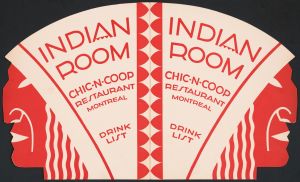
![Graphic designs for Longchamps Restaurants.] [Cocktail card](/imgs/249257/s/winold-reiss-graphic-designs-for-longchamps-restaurants-cocktail-card-a188d857.jpg)
![[Design drawing for Manhattan House Longchamps Restaurant, corner of 3rd Avenue and 65th Street, New York, NY.] [Study for mosaic front](/imgs/249260/s/winold-reiss-design-drawing-for-manhattan-house-longchamps-restaurant-corner-of-3rd-avenue-and-65th-street-new-york-ny-study-for-mosaic-front-441f1ed6.jpg)
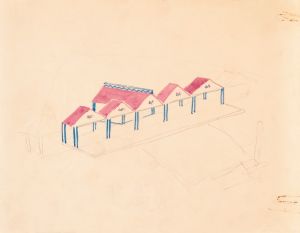

![Exhibit design with stage in form of folding screen.] [Sketch of exhibit with modern chairs and tables](/imgs/249343/s/winold-reiss-exhibit-design-with-stage-in-form-of-folding-screen-sketch-of-exhibit-with-modern-chairs-and-tables-b25d6d6d.jpg)
![Interior design sketches for Alamac Hotel, 71st and Broadway, New York, NY.] [Incomplete interior perspective of a hallway](/imgs/249365/s/winold-reiss-interior-design-sketches-for-alamac-hotel-71st-and-broadway-new-york-ny-incomplete-interior-perspective-of-a-hallway-e54f10f2.jpg)
![Interior perspective drawings of Hotel Siwanoy, Mount Vernon, NY.] [Interior perspective of dining room](/imgs/249368/s/winold-reiss-interior-perspective-drawings-of-hotel-siwanoy-mount-vernon-ny-interior-perspective-of-dining-room-d26480cd.jpg)
![Design sketches for stepped, three-panel, painted decorative folding screens.] [Drawing of plans, elevation, and details](/imgs/249416/s/winold-reiss-design-sketches-for-stepped-threepanel-painted-decorative-folding-screens-drawing-of-plans-elevation-and-details-cebab690.jpg)
![Drawings for proposed decorations of Mike Lyman’s Restaurant, 424 W. Sixth St., Los Angeles, CA.] [Drawing #10, Scheme 1; Color scheme for ceiling – main dining room](/imgs/249426/s/winold-reiss-drawings-for-proposed-decorations-of-mike-lymans-restaurant-424-w-sixth-st-los-angeles-ca-drawing-10-scheme-1-color-scheme-for-ceiling-main-dining-room-6113fb5a.jpg)
